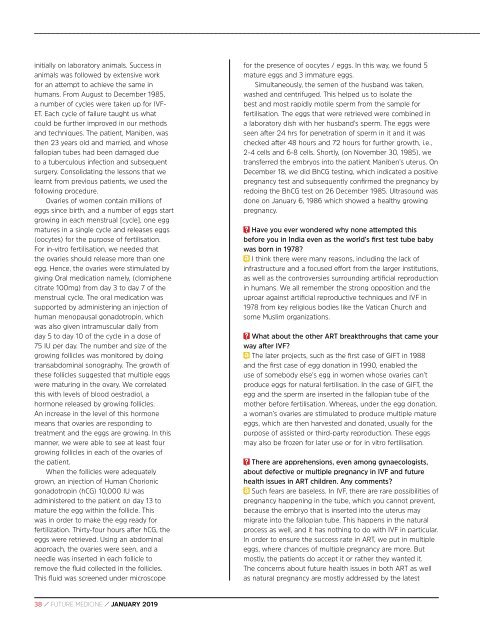FM JANUARY 2019 - digital edition
Create successful ePaper yourself
Turn your PDF publications into a flip-book with our unique Google optimized e-Paper software.
initially on laboratory animals. Success in<br />
animals was followed by extensive work<br />
for an attempt to achieve the same in<br />
humans. From August to December 1985,<br />
a number of cycles were taken up for IVF-<br />
ET. Each cycle of failure taught us what<br />
could be further improved in our methods<br />
and techniques. The patient, Maniben, was<br />
then 23 years old and married, and whose<br />
fallopian tubes had been damaged due<br />
to a tuberculous infection and subsequent<br />
surgery. Consolidating the lessons that we<br />
learnt from previous patients, we used the<br />
following procedure.<br />
Ovaries of women contain millions of<br />
eggs since birth, and a number of eggs start<br />
growing in each menstrual [cycle], one egg<br />
matures in a single cycle and releases eggs<br />
(oocytes) for the purpose of fertilisation.<br />
For in-vitro fertilisation, we needed that<br />
the ovaries should release more than one<br />
egg. Hence, the ovaries were stimulated by<br />
giving Oral medication namely, (clomiphene<br />
citrate 100mg) from day 3 to day 7 of the<br />
menstrual cycle. The oral medication was<br />
supported by administering an injection of<br />
human menopausal gonadotropin, which<br />
was also given intramuscular daily from<br />
day 5 to day 10 of the cycle in a dose of<br />
75 IU per day. The number and size of the<br />
growing follicles was monitored by doing<br />
transabdominal sonography. The growth of<br />
these follicles suggested that multiple eggs<br />
were maturing in the ovary. We correlated<br />
this with levels of blood oestradiol, a<br />
hormone released by growing follicles.<br />
An increase in the level of this hormone<br />
means that ovaries are responding to<br />
treatment and the eggs are growing. In this<br />
manner, we were able to see at least four<br />
growing follicles in each of the ovaries of<br />
the patient.<br />
When the follicles were adequately<br />
grown, an injection of Human Chorionic<br />
gonadotropin (hCG) 10,000 IU was<br />
administered to the patient on day 13 to<br />
mature the egg within the follicle. This<br />
was in order to make the egg ready for<br />
fertilization. Thirty-four hours after hCG, the<br />
eggs were retrieved. Using an abdominal<br />
approach, the ovaries were seen, and a<br />
needle was inserted in each follicle to<br />
remove the fluid collected in the follicles.<br />
This fluid was screened under microscope<br />
for the presence of oocytes / eggs. In this way, we found 5<br />
mature eggs and 3 immature eggs.<br />
Simultaneously, the semen of the husband was taken,<br />
washed and centrifuged. This helped us to isolate the<br />
best and most rapidly motile sperm from the sample for<br />
fertilisation. The eggs that were retrieved were combined in<br />
a laboratory dish with her husband’s sperm. The eggs were<br />
seen after 24 hrs for penetration of sperm in it and it was<br />
checked after 48 hours and 72 hours for further growth, i.e.,<br />
2-4 cells and 6-8 cells. Shortly, (on November 30, 1985), we<br />
transferred the embryos into the patient Maniben’s uterus. On<br />
December 18, we did BhCG testing, which indicated a positive<br />
pregnancy test and subsequently confirmed the pregnancy by<br />
redoing the BhCG test on 26 December 1985. Ultrasound was<br />
done on January 6, 1986 which showed a healthy growing<br />
pregnancy.<br />
Have you ever wondered why none attempted this<br />
before you in India even as the world’s first test tube baby<br />
was born in 1978?<br />
I think there were many reasons, including the lack of<br />
infrastructure and a focused effort from the larger institutions,<br />
as well as the controversies surrounding artificial reproduction<br />
in humans. We all remember the strong opposition and the<br />
uproar against artificial reproductive techniques and IVF in<br />
1978 from key religious bodies like the Vatican Church and<br />
some Muslim organizations.<br />
What about the other ART breakthroughs that came your<br />
way after IVF?<br />
The later projects, such as the first case of GIFT in 1988<br />
and the first case of egg donation in 1990, enabled the<br />
use of somebody else’s egg in women whose ovaries can’t<br />
produce eggs for natural fertilisation. In the case of GIFT, the<br />
egg and the sperm are inserted in the fallopian tube of the<br />
mother before fertilisation. Whereas, under the egg donation,<br />
a woman’s ovaries are stimulated to produce multiple mature<br />
eggs, which are then harvested and donated, usually for the<br />
purpose of assisted or third-party reproduction. These eggs<br />
may also be frozen for later use or for in vitro fertilisation.<br />
There are apprehensions, even among gynaecologists,<br />
about defective or multiple pregnancy in IVF and future<br />
health issues in ART children. Any comments?<br />
Such fears are baseless. In IVF, there are rare possibilities of<br />
pregnancy happening in the tube, which you cannot prevent,<br />
because the embryo that is inserted into the uterus may<br />
migrate into the fallopian tube. This happens in the natural<br />
process as well, and it has nothing to do with IVF in particular.<br />
In order to ensure the success rate in ART, we put in multiple<br />
eggs, where chances of multiple pregnancy are more. But<br />
mostly, the patients do accept it or rather they wanted it.<br />
The concerns about future health issues in both ART as well<br />
as natural pregnancy are mostly addressed by the latest<br />
38 / FUTURE MEDICINE / <strong>JANUARY</strong> <strong>2019</strong>


















